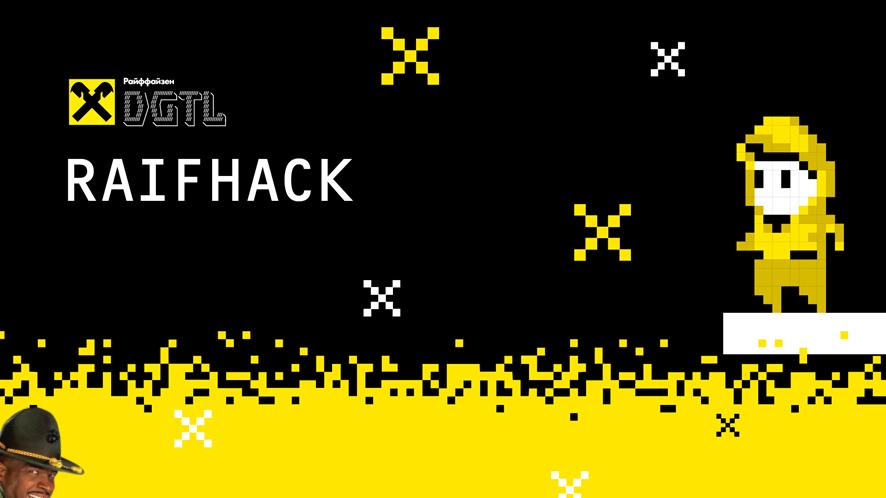
If you remember, we recently published the announcement of the RAIFHACK hackathon , which took place online on November 14-15 together with the Russian Hackers team. It would seem that this is an ordinary hackathon. But it had everything: denial, anger, bargaining, depression, acceptance, jokes and, of course, memes.
The main agenda of RAIFHACK was to create solutions for small and medium-sized businesses in two tracks:
- Know the customer and the competitor is about data usage. Participants developed a product in the Data as a Service paradigm based on anonymized customer data.
- « — » — API . - API , .
Servicing small and medium-sized businesses is a priority for our bank.
We monitor customer requests in this area and try to immediately introduce new services for them. We are talking about both standardized and flexible IT solutions. For example, we have become a leader in the implementation of the fast payment system (FPS) in our products. This is one of the first solutions on the Russian market that allows invoicing customers directly from the seller's smartphone.
If we talk about products in the Data as a Service paradigm, then the background is this: in 2019, after numerous custom devs with loyalty program partners, we got the following picture: the business is acutely aware of the lack of objective information about its customers in a real competitive environment.
Further research led to the creation of our product Data as a Service, similar to the SaaS model. Within its framework, several business cases have already been implemented, which are based on the intersection of data on customer purchases and data on behavior and interests of customers in social networks. But such an analysis is not the limit, and we are interested in any ideas in this direction.
Format, registration, timeline
At RAIFHACK, we decided not to follow the classic hackathon, when teams receive a task and 24-48-72 hours to complete it. We wanted the participants to dive into the product from the start. So the CJM was like this:
- register as a team;
- get acquainted with the task of the track and send your product idea;
- qualify for the final;
- get a dataset and access to the API at the final, finalize the product and present a demo.
The topic of the hackathon was narrow, but we received 900+ individual registrations, 100+ team decisions at the selection stage, and 28 teams reached the final.
Perhaps the selection stage will always be the bottleneck of any competition. There will always be projects that you liked more, and projects that did not reach the jury or did not convince them. So it was with us - and this caused a tsunami. The denial began when we announced the results of the qualifying round.
Having received 60 ideas in the DaaS track and 51 in the SBP, we started evaluating the applications. The solutions were watched by track mentors: at least grocery and technical + additional. Already at the selection stage, we evaluated how feasible the solution was - for example, in the DaaS track, the DS component had a huge weight, which is why many teams received a very low score in this part. These assessments have generated a lot of anger. As well as the fact that some projects were viewed by a larger number of mentors, others - by a smaller number, and those that aroused more keen interest received a higher rating. In general, this corresponds to a real situation when a startup presents an idea to an investor.
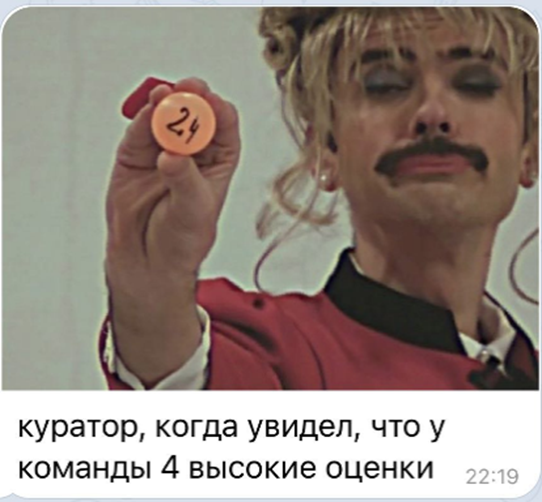
Not without emotional reactions :)
Let's not pretend that we are white and fluffy - we also had a joint. The results were summed up in a hurry, and the formula was trite in one of the tables. As a result, we rolled out the results with an error. Thanks to the participants for noticing this, albeit a shame. So we got 5 more teams to the final of the SBP category, and we were rightly reprimanded with the phrase "bang-bang - and into production!"
You can argue endlessly about the system of evaluating ready-made solutions. We have one vision, some participants have a different one. Anger spawned angry comments, memes, and demotivators (sic!).

At the stage of bargaining, a petition appeared on change.org for the cancellation of the hackathon results and even an invitation to all those who did not make it to the final to gather on Discord for a rally and arrange their independent pitches. Predicting the next stage, one of the participants created a bot on Telegram to provide psychological assistance to victims of judicial arbitrariness.
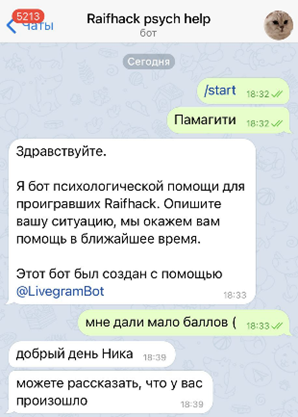
Despite everything, the final took place and was held on November 14-15. The schedule was extremely tight, and we expected that one to three teams would simply not make it to the end - this is normal for such hackathons. Surprisingly, we all made it to the end!
Hackathon, coding and hardcore
The hackathon schedule is tough, the dataset is huge, it took a lot of cutting, and as many as 3 points of control by mentors and not tested by the API teams. Participants had to connect and hand over what they had, otherwise the team was removed from the distance.
We divided all checkpoints into 3 stages:
- idea and implementation plan;
- draft prototype;
- editing of the prototype + discussion of the presentation.
Each checkpoint is a demonstration of development progress and receiving feedback from two mentors within a call for 15-20 minutes. One mentor was responsible for the product, the second for the technical component of the project. Based on the results of the call, the mentors decided whether to skip the team further or not. This approach helped to better plan the work of participants, gave regular retrospectives and synchronized teams, and it was easier for mentors in this format to track progress.
The check-point grid from the mentors' side looked something like this:

In fact, the mentors did a feat and worked in that rhythm all weekend. They encouraged the teams and stayed in touch with them. The participants themselves noted this already at the end of the hackathon: “Excellent! The mentors looked from the outside and really helped us make the project better. Very detailed and friendly answers. "
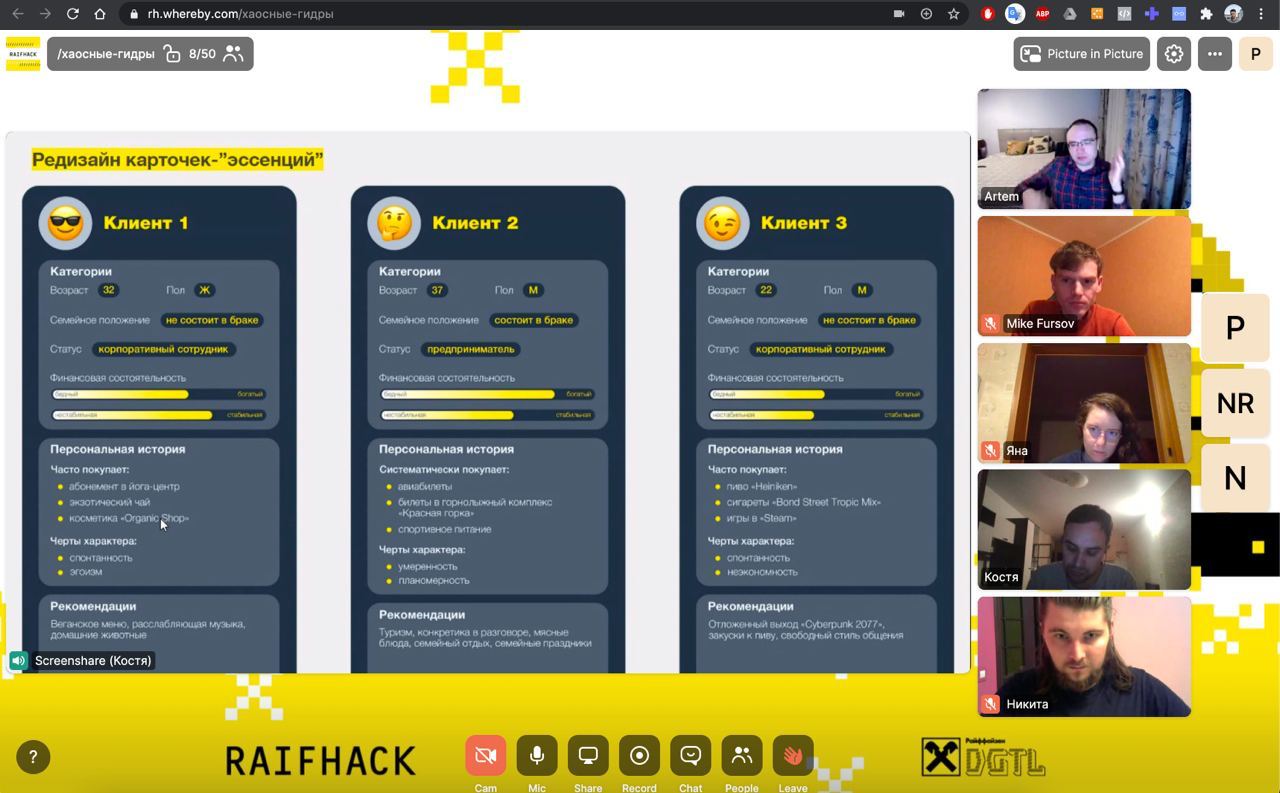
Some teams faced technical problems, others were stuck with ideas, and one of them in the process was completely abandoned by two participants, including their team lead. This team has only one developer and a 14-year-old designer left. Yes, the youngest participant in the hackathon was 14 years old. It was Sveta Simak, she is from St. Petersburg and the whole event was in the lead in our unofficial list of "Organizational Sympathy Prize".
Demo and pitches
Everyone got to the demo. This time we decided not to divide the performances and listened to all the teams in a single stream. It was an experiment, and it turned out to be not the most successful, it's true. We admit it ourselves: 28 presentations in a row is too much. We received five proposals to divide the performances into stages, but most of them were quite interested in watching other people's projects.
Not all of the performances went smoothly. The timing was very tight: exactly 5 minutes for a speech and 2 minutes for questions. At a crucial moment, one of the teams lost the Internet at all. But everyone did it, and it was really cool and interesting! One team even rented a vending "grab" specially for the presentation at the final!
The assessment was made on a 10-point scale. The jury had to try hard to highlight the best projects. The choice was made not only by a mathematical principle, but also from the point of view of an investor who is going to invest in a particular project. Therefore, in addition to the coefficients, there was also such a factor as subjectivity, at the level of "liked it - did not like it." This makes it possible to bring the conditions of the hackathon closer to the conditions of a business incubator, when the authors of an idea need not only to present it, but to show its viability and prove its prospects at a subjective level.
Who won? Next, we will tell you about the projects that won in their areas.
DaaS Winner - Team "DS29"

The essence of the project: a service for a group of subscriptions from business clients of the bank with the formation of an offer based on customer transactions.
Project objective: to develop a product in the “Data as a Service” paradigm based on data about customers and their transactions.
How we solved the problem: we created "PRime" - a subscription service from the bank's business clients to end users. This is a flexible system of subscription groups, which is formed on the basis of customer data on transactions, which will allow the bank, customers and end users to stay in the black and spend their time more efficiently.
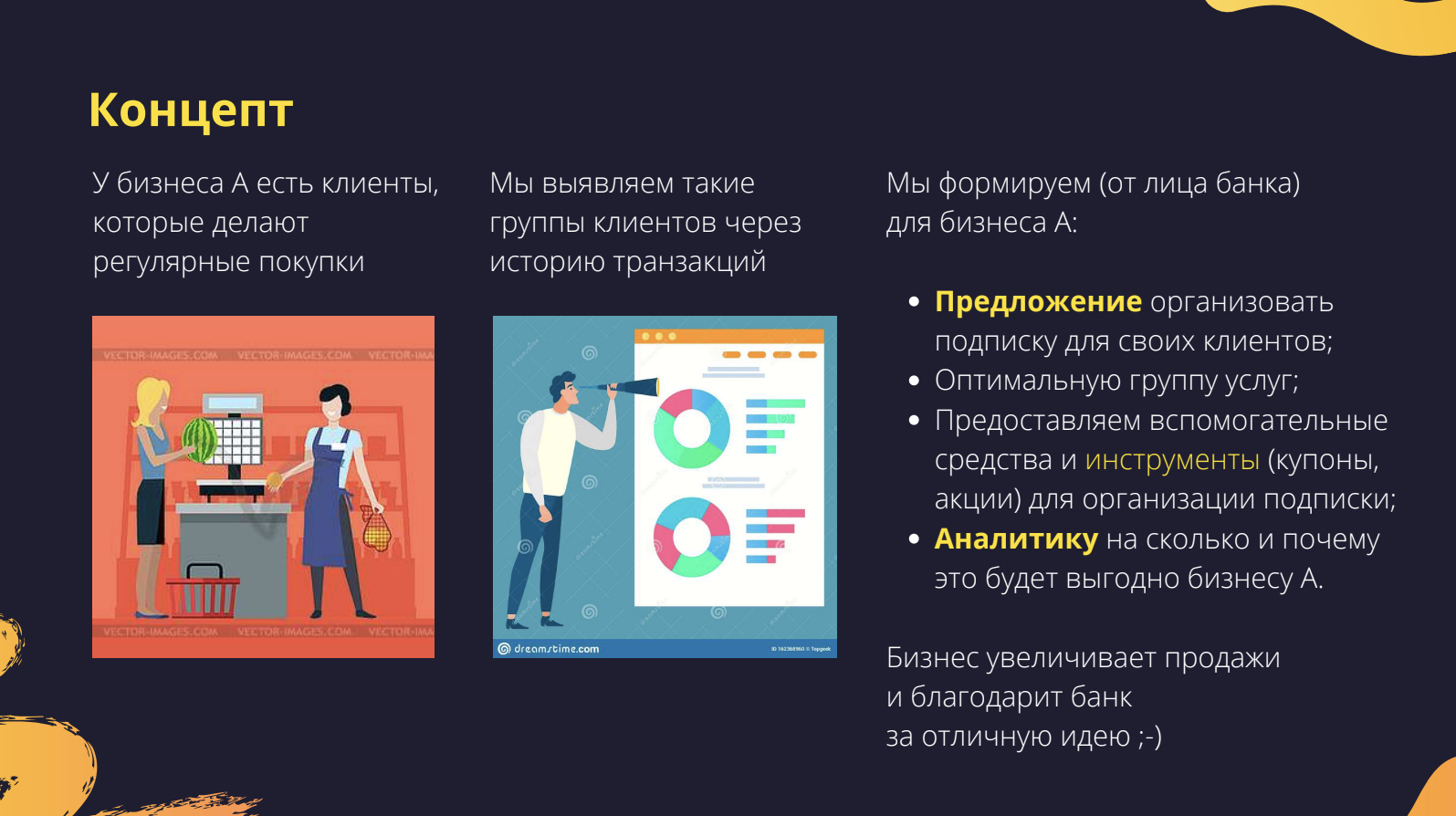
Here you can download the presentation of the project.
« , , :) , , . , » — , .
« : - , , », — , Data Scientist.
— «LIFE Laboratory»

The essence of the project: an application that enables a business to use a phone as a terminal, processing customer orders through a web interface.
The task of the project: development of a system for fast and convenient payments through the bank's SBP with the ability to use the NFC-module of a smartphone - a device that is always at hand.
Prospects: development of a real website and application that will enable business clients to offer each other mutually beneficial cooperation.
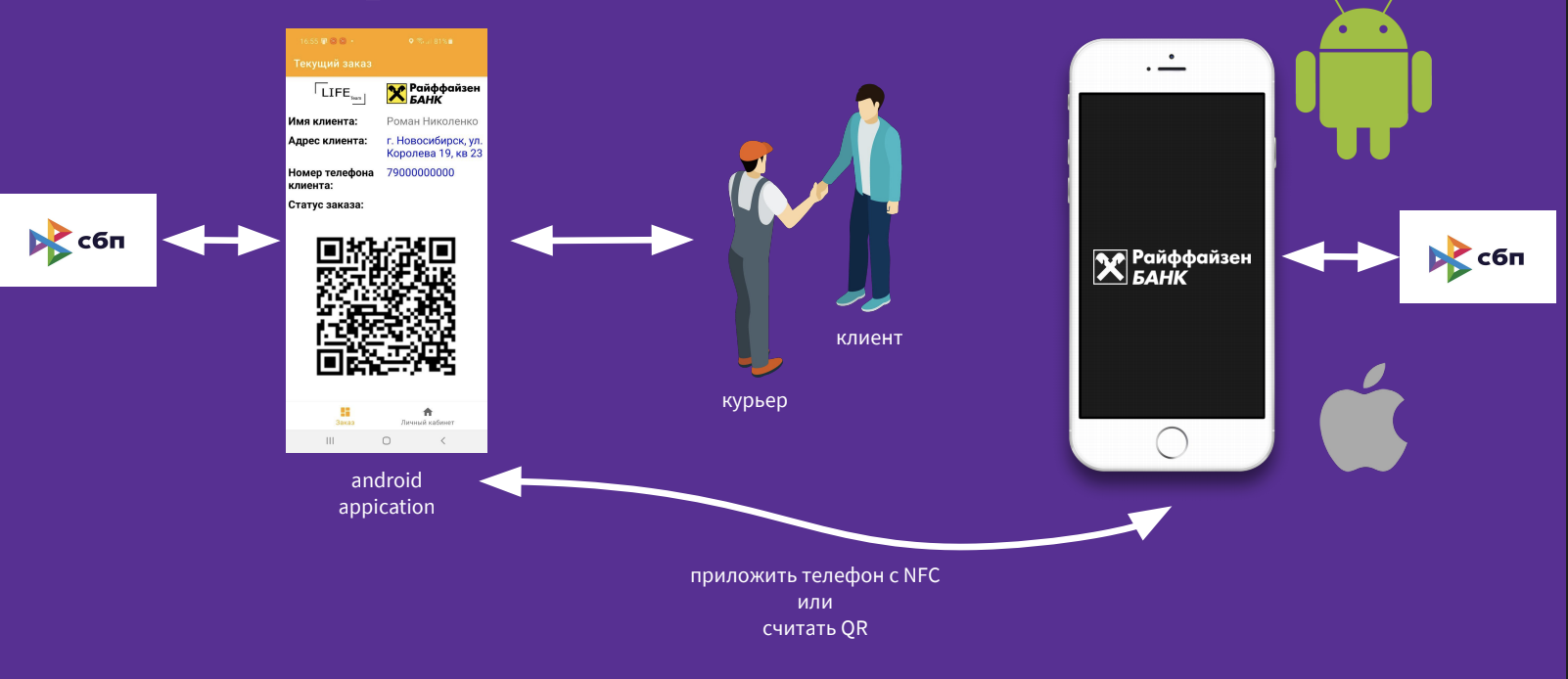
How we solved the problem:implemented the application "NFC for SFP", which receives from the operator a QR code with data embedded for payment. The client receives data via NFC that allows him to select his bank-application, after which he only has to press the button “confirm payment”. In a normal situation, the courier has to take a payment terminal with him; most models of such devices are rather heavy and inconvenient, plus expensive. It is much easier to use a smartphone with an NFC module.
For the project, both the application itself and the web service, or rather the web interface of the application, have been developed. The web interface of the application is intended for the operator, on which the customer's order is formed, a QR code is generated for payment, after which all this is transmitted to the courier.

Here you can download the presentation of the project.
« 500 «», , . , , , , , », — , backend-.
All presentations of the teams can be viewed and evaluated here , and here there is also the award ceremony .
The total prize fund was 500,000 rubles . In each track for the first place, a cash prize of 150,000 rubles was paid per team, as well as an expanded pack of our bank's branded merchandise was presented. For the second place, 100,000 rubles were paid. For the third place, each participant received airpods and merch. All other teams received merch and our unlimited gratitude for their participation, and we presented branded slippers to the creator of the petition on change.org, which he was very happy with :)

See you at the next RAIFHACK!